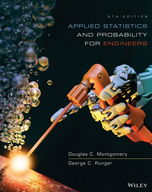Ch 12.6 - 115SE
Chapter 12, Problem 115SE(choose chapter or problem)
A multiple regression model was used to relate y = viscosity of a chemical product to \(x_{1}\) = temperature and \(x_{2}\) = reaction time. The data set consisted of n = 15 observations.
(a) The estimated regression coefficients were \(\hat{\beta}_{0}=300.00\), \(\hat{\beta}_{1}=0.85\), and \(\hat{\beta}_{2}=10.40\). Calculate an estimate of mean viscosity when \(x_{1}=100^{\circ} \mathrm{F}\) and \(x_{2}=2\) hours.
(b) The sums of squares were \(S S_{T}=1230.50\) and \(S S_{E}=120.30\). Test for significance of regression using \(\alpha=0.05\). What conclusion can you draw?
(c) What proportion of total variability in viscosity is accounted for by the variables in this model?
(d) Suppose that another regressor, \(x_{3}\) = stirring rate, is added to the model. The new value of the error sum of squares is \(S S_{E}=117.20\). Has adding the new variable resulted in a smaller value of \(M S_{E}\)? Discuss the significance of this result.
(e) Calculate an F-statistic to assess the contribution of \(x_{3}\) to the model. Using \(\alpha=0.05\), what conclusions do you reach?
Unfortunately, we don't have that question answered yet. But you can get it answered in just 5 hours by Logging in or Becoming a subscriber.
Becoming a subscriber
Or look for another answer
